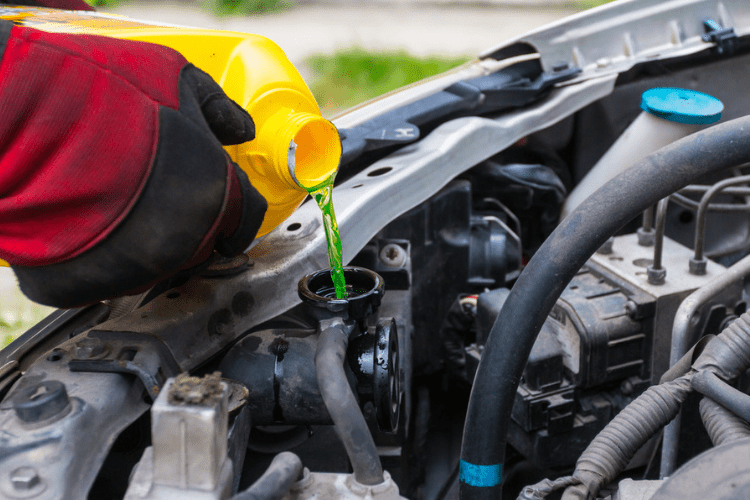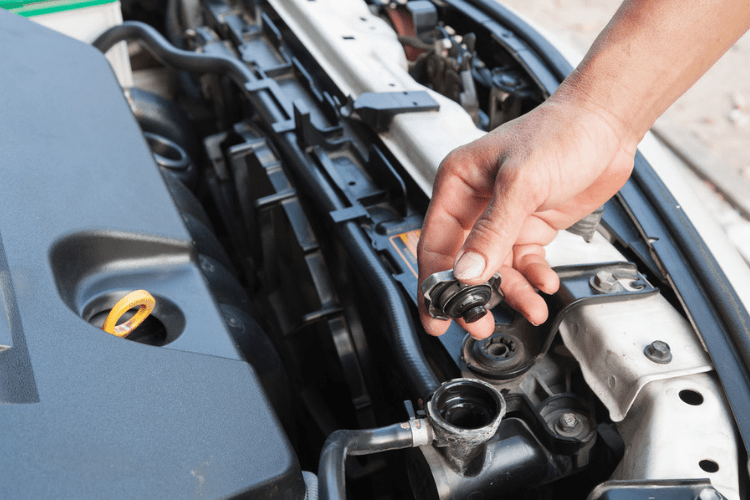Radiator Leak Repair
If you see a puddle of liquid under your car and think it could be coolant, you might have a radiator leak. The best way to proceed is to find out for sure what kind of leak it is, and then fix it! Otherwise, if you try to drive your car and it turns out the coolant is leaking, you could end up overheating your car and causing expensive damage to the engine. Luckily, learning how to fix a radiator leak only takes minutes. Here’s how to get started.

Radiator Leak Repair: Get Ready to Inspect the Car
First, you want to make sure the liquid is actually coming from your radiator, so be prepared to spend a few minutes looking for the leak. Keep in mind that the coolant may be hot and can damage your skin or eyes if it gets on you, so wear gloves and safety glasses to be on the safe side—and only inspect your car when the engine is cold.
Radiator Leak Repair: Find the Leak
Now it’s time to find the leak. You might initially think the coolant is coming from your radiator, but it could also be coming from a radiator hose or clamp. The easiest way to determine this is to visually inspect the radiator until you see where the coolant is coming from. If it seems to be coming from a loose clamp, you can simply tighten it to stop the leak. And if it’s coming from a radiator hose, you can replace it. But if it’s clear the leak is in the radiator itself, you can typically fix it within minutes.

How to Fix a Radiator Leak
Knowing how to fix a radiator leak involves learning your options and then choosing the right one for you. You should know that the most popular—and easiest—way to fix a radiator leak is to use a stop-leak product that you simply pour into the radiator. For example, AlumAseal Radiator Stop Leak & Conditioner can quickly fill any small holes in the cooling system. Once you pour it in, you can check your coolant level and top it off if necessary, and then get on with your day—knowing your radiator leak has been fixed!
If you don’t have any stop-leak products on hand when you notice the radiator leak, there are a couple of alternative ways to temporarily stop the leak so you can safely drive to the store to get some. One option is to use egg yolks. This may sound odd, but the eggs will congeal enough to seal tiny leaks, and the effect should last long enough for you to get ahold of a better option, like AlumAseal. Just note that you have to separate the egg whites from the yolks of about four eggs, and then pour just the yolks into the cooling system. Then start your engine to help the eggs go far enough in the system and start to congeal.
Note that black pepper will have the same effect, since if you pour about half a pepper shaker’s worth of this substance into the cooling system, it will seal the leak. Just keep in mind that both eggs and black pepper are temporary fixes and should never be used as a permanent way to stop a radiator leak. They should allow you just enough time to pick up a stop-leak product so you can fix the issue.
Of course, some radiator leaks require more serious help that only a mechanic can provide. For instance, if you check for leaks and see that your coolant is running out of your radiator, not just dripping, it may be time to take your car to the repair shop. But for most radiator leaks, a simple stop-leak product should take care of the problem!





Leakage of the coolant could affect the performance of the cooling system in a very adverse way. Lack of an adequate amount of coolant could affect the efficiency of the cooling system in a very adverse way. Glycol is used as the coolant which has a special ability to absorb the excess amount of heat energy generated by the engine due to the internal combustion which could affect the performance of the engine in a very negative way. So, the coolant level needs to be inspected regularly and if necessary should be replaced with suitable substitutes. Lack of maintenance is solely responsible for the development of mechanical abnormalities in the car.
Very helpful article. Easy to understand for a very unmechanical person such as myself